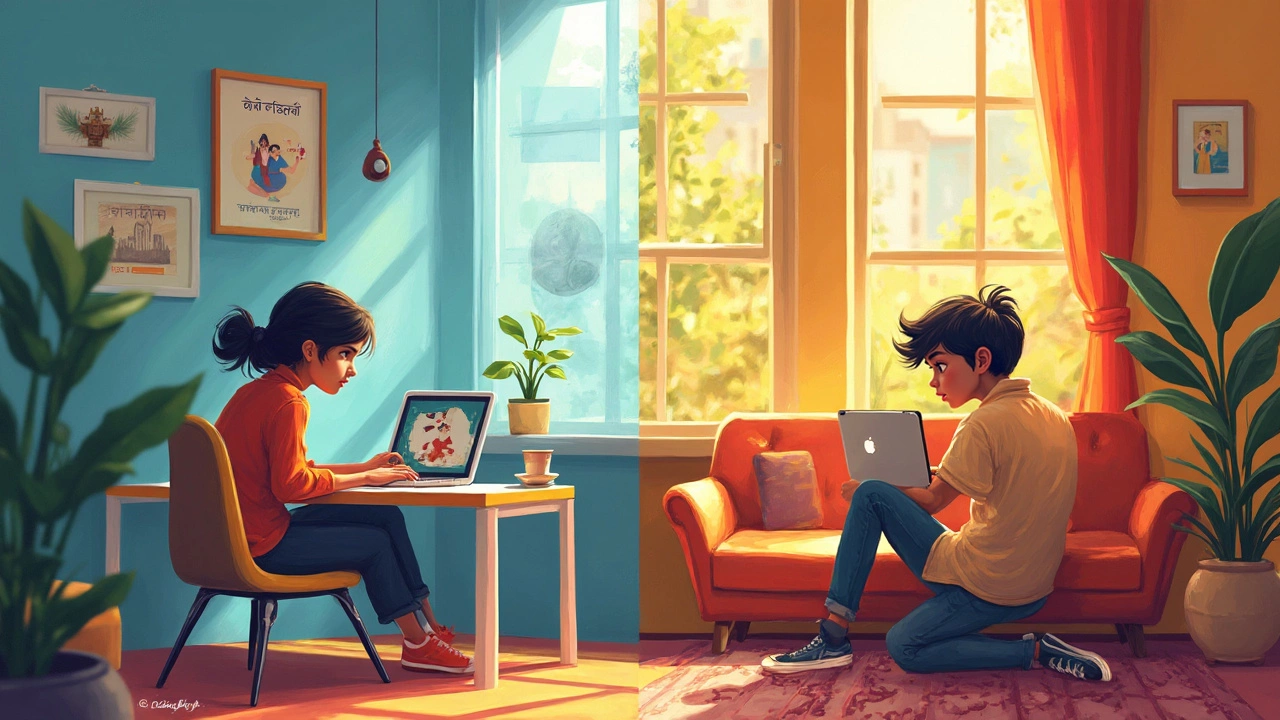14 Jun
2025
Distance vs Online Learning: What Sets Them Apart?

If you think distance learning and online learning are just two words for the same thing, you’re not alone—most people do. But here’s the thing: they’re not actually the same. The way you learn, connect with teachers, and even how you fit classes into your life can be totally different depending on which model you use.
Ever wonder why your friend does Zoom classes every morning while you’re stuck mailing in assignments for weeks? There’s a reason. Knowing the difference can save you a lot of headaches (and maybe some cash) when you choose a program. Whether you need more structure, crave flexibility, or just want to avoid a tech meltdown, this stuff matters.
- What Does Distance Learning Actually Mean?
- How ‘Online Learning’ Changes the Game
- Tech Tools and Access: What You’ll Need
- Student Experience: Structure vs Flexibility
- Tips for Choosing the Right Path
What Does Distance Learning Actually Mean?
Distance learning is older than the internet—and way older than Zoom calls. Picture a college that mails thick workbooks and tests to students living across the country. That’s the core of distance learning: you’re not on campus, and all your learning happens remotely, no matter where you are.
It’s not just about technology. Traditional distance learning might depend on mail, recorded lectures on DVDs, phone check-ins, or even radio broadcasts. Today, some programs blend these old-school methods with email or basic web platforms, but the key thing is you don’t have to be online to do the lessons, and you’re rarely expected to show up at a set time.
Here’s where it gets interesting—distance learning usually gives way more freedom. You learn at your speed. Many programs even accept assignments by mail. No group video calls and usually no real-time chats with classmates.
- Materials often sent or accessed in batches (workbooks, CDs, printed guides)
- Can include exams you take at home and mail back
- No fixed daily or weekly class meetings
- You don’t need high-speed internet—sometimes you barely need internet at all
- Communication with teachers is usually slower and less frequent
Why do people stick with distance learning? Well, it's great if you work irregular hours, have spotty internet, or just don’t want to juggle live class schedules. Open University in the UK, for example, has offered distance degrees for decades using this model, and nearly 175,000 students signed up in 2023 alone.
| Key Feature | Distance Learning |
|---|---|
| Tech Needed | Bare minimum (sometimes just mail or basic web access) |
| Live Classes | Rare—mostly self-paced |
| Assignments | Mail, email, or basic uploads |
| Student Schedule | Very flexible, no set class times |
So, if you’re looking for maximum flexibility and don’t want to worry about fast internet or fixed class times, distance learning might be right up your alley.
How ‘Online Learning’ Changes the Game
Online learning takes the whole idea of studying from home and gives it a technology boost. You don’t just send paperwork back and forth—you log in, see your classmates, get instant feedback, and sometimes even learn at your own pace. The big change here is that everything’s digital. Most courses use platforms like Canvas or Google Classroom for lectures, assignments, and grades. According to data from the National Center for Education Statistics, over 75% of U.S. colleges now offer fully online classes. That’s a huge shift from just a decade ago.
The real kicker? Online classes often happen in real time, with live video sessions. Interaction is a big deal. You can raise your hand (virtually), chat in real time, and even pop into breakout rooms for group work. Flexibility is higher too. Some programs upload recordings if you can’t make it, so you’re not locked out for missing a session.
"The digital classroom can actually boost engagement among students who wouldn’t usually speak up in a face-to-face setting," says Dr. Michael Morris, an education tech specialist at Harvard.
If you’re the type who likes staying ahead, online platforms send you reminders for deadlines, let you check your progress, and even give you instant quizzes. There’s less waiting around for grades or feedback. Plus, tools like discussion boards and shared docs make group projects doable even when classmates live hours apart.
- You need steady internet and a basic laptop or tablet.
- Most platforms work both in browsers and as mobile apps—super handy if you’re on the go.
- Some courses let you set your own pace; others run live on a fixed schedule.
It’s no surprise that online learning is becoming the go-to choice for anyone who wants flexibility, tech support, and real-time answers instead of waiting weeks for snail mail responses.

Tech Tools and Access: What You’ll Need
No matter which way you go in distance education, the tech stuff makes all the difference. For distance learning, you can get by with basics: a decent computer or even a tablet, an email account, and maybe a printer if you’re mailing homework. Some distance courses still send workbooks and paper tests, so you don’t have to live online 24/7. People use these setups all the time, especially if their internet is spotty.
But for truly online learning, you’ll almost always need solid, reliable internet. You’ll use video calls, virtual classrooms, online tests—sometimes all in the same day. Here’s a quick breakdown of the essentials for each style:
- Distance learning: Computer/laptop, printer, scanner or smartphone for snapping assignment pics, email access. Sometimes mailing costs for hard-copy work.
- Online learning: Fast Wi-Fi, webcam, headset or microphone, up-to-date browser (Chrome, Edge, or Firefox), accounts on apps like Zoom, Google Classroom, or Canvas.
Surprisingly, not every student has all this at home. A 2023 Pew Research stat showed about 16% of US households with kids didn’t have reliable internet or a working computer for school. That’s a lot of learners stuck figuring things out.
| Tech Need | Distance Learning | Online Learning |
|---|---|---|
| Internet Connection | Optional (sometimes) | Required |
| Printer/Scanner | Often necessary | Rarely used |
| Webcam/Mic | Not needed | Usually required |
| Must-have | Must-have | |
| Learning Apps | Rarely used | Always used |
Tip: Double-check your program’s requirements before you start. For example, some colleges lend out laptops or give discounts on internet if you ask. Don’t get blindsided by buying stuff you don’t need or missing something you can’t study without.
Student Experience: Structure vs Flexibility
This is where things start to feel really different, depending on which model you pick. The classic distance learning setup usually leans on structure. Think mailed study guides, fixed deadlines for assignments, and sometimes even specific exam weeks you can’t wiggle around. Schools have been running distance programs like this for decades—way before Wi-Fi was a household word. Most of the time, you work solo, with set milestones to hit, and there may not be a ton of direct back-and-forth with your teachers or classmates.
Online learning usually gives you more flexibility, which is why it’s so popular. Classes might be “live” with video chats and active discussions, but a lot of the content is available 24/7 on platforms like Canvas or Google Classroom. You pick when you want to watch lectures or finish assignments. This setup is a lifesaver if you work odd hours or have a packed schedule at home. Some programs even let you finish courses way faster—or slower—than a regular semester timeline.
Of course, flexibility isn’t always a win for everyone. If you need someone checking in on you or you’re the type who procrastinates, those strict distance courses with fixed deadlines sometimes feel easier to handle. For self-starters who hate waiting around, online learning’s “learn as you go” vibe can help you finish early and move on.
One surprising point: a 2023 report from the National Center for Education Statistics found students in online programs often ask for more contact with instructors because isolation can be an issue—even with all that tech. So, if regular feedback and real-time conversations matter to you, look closely at each program’s interaction style before jumping in.

Tips for Choosing the Right Path
Picking between distance and online learning can seem confusing, but you can make it easier by thinking about your daily life, tech skills, and learning style. Not all programs fit everyone the same way. Here’s what you really need to look at:
- Online learning usually leans on technology—think live video calls, instant feedback, and digital resources. If you have solid internet, a reliable computer, and feel good about using apps or logging into learning platforms, this option can offer quick answers and real-time interactions. A 2023 survey showed over 75% of students in online universities said they liked getting faster support from teachers and classmates.
- Distance learning, on the other hand, might not always mean being online. Some courses still use mailed assignments or recorded video lectures you can access any time. This can work for folks in rural areas or anyone juggling work, family, or unpredictable schedules. The trade-off? There’s often less social connection and slower feedback.
- Ask yourself how much structure you want. Online classes feel more like a "real" classroom with set meeting times. Distance programs usually hand you the materials and let you move at your own speed. If motivation is hard for you, having regular live sessions might keep you on track.
- Check how programs handle tech support and accessibility. Some colleges loan out laptops or provide mobile-friendly platforms, while others assume you’ve already got the gear. Look for honest student reviews or program FAQs—don’t just trust the glossy marketing.
- Don’t forget about your end goals. If you need a specific certification or degree, make sure the program is recognized by employers in your field. Some licensing bodies only accept certain types of study formats, so do a quick check on official websites before you commit.
In the end, the "right" path is the one that fits your life—not just what sounds trendy. Write down what matters most for you—whether it’s flexibility, tech access, quick feedback, or recognized credentials—then see which option ticks the most boxes. Your education should fit you, not the other way around.
Write a comment ( All fields are required )